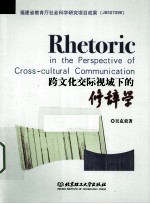
- 作 者:吴克炎著
- 出 版 社:北京:北京理工大学出版社
- 出版年份:2010
- ISBN:9787564032333
- 标注页数:234 页
- PDF页数:246 页
请阅读订购服务说明与试读!
订购服务说明
1、本站所有的书默认都是PDF格式,该格式图书只能阅读和打印,不能再次编辑。
2、除分上下册或者多册的情况下,一般PDF页数一定要大于标注页数才建议下单购买。【本资源246 ≥234页】
图书下载及付费说明
1、所有的电子图书为PDF格式,支持电脑、手机、平板等各类电子设备阅读;可以任意拷贝文件到不同的阅读设备里进行阅读。
2、电子图书在提交订单后一般半小时内处理完成,最晚48小时内处理完成。(非工作日购买会延迟)
3、所有的电子图书都是原书直接扫描方式制作而成。
Chapter One Introduction 1
Ⅰ.Definitions of rhetoric 1
A.Denotation of rhetoric 1
B.Connotation of rhetoric 1
C.Six basic features of good expressions 3
Ⅱ.Functions of rhetoric 14
A.Being more appropriate 15
B.Being more attractive 15
C.Being more forcible 15
D.Being more humorous 16
Ⅲ.Classification of rhetoric 17
Ⅳ.Rhetoric in the perspective of cross-cultural communication 18
Chapter Two Comparison and Contrast Between English and Chinese Rhetoric 20
Ⅰ.Language and rhetoric 20
Ⅱ.Language,rhetoric and thought 21
Ⅲ.English and Chinese rhetoric 22
A.Passive rhetorical techniques 23
B.Active rhetorical techniques 24
Chapter Three The Faculty of Rhetorical Invention 32
Ⅰ.The origin of rhetorical invention 32
Ⅱ.The essence of rhetorical invention 33
Ⅲ.The cases of rhetorical invention 33
A.Controversial topic 33
B.Non-controversial topic 43
Chapter Four Passive Rhetorical Techniques 48
Section One Contextual Choice of Words and Expressions 49
Ⅰ.Being fit for a certain situation 49
Ⅱ.Being appropriate stylistically 52
A.English examples 52
B.Chinese examples 54
Ⅲ.Being idiomatic 54
A.Using idioms 54
B.Using words in their figurative sense in English vs.words with vague reference or enigmatic folk similes in Chinese 56
Section Two Textual Choice of Words,Expressions and Sentence Structures 60
Part 1 English Prominent Feature:Elegant Variation 60
Ⅰ.The solid basis 62
A.Vocabulary 62
B.Grammar 63
Ⅱ.Various forms of variation 67
A.Forms in diction 67
B.Forms in sentence structures 70
Part 2 Chinese Prominent Features 77
Ⅰ.Sentence structure:elegance of balance 78
Ⅱ.Elegance of artistic conception 79
Section Three Application 81
Part 1 Application of the English Prominent Features 81
Ⅰ.Elegant variation 81
A.Forms in diction 81
B.Forms in sentence structures 87
Ⅱ.English words in their figurative sense 91
Part 2 Application of the Chinese Prominent Features 93
Ⅰ.Chinese balanced structures 93
Ⅱ.Periodic sentences 93
Ⅲ.Chinese words with vague reference 94
Ⅳ.Xiehouyu 95
Part 3 Application of English/Chinese Idiomaticness 95
Chapter Five Active Rhetorical Techniques 97
Section One Devices Whose Rhetorical Effects Can Generally Be Retained 101
A.Apostrophe 101
B.Asyndeton,poly-syndeton 104
C.Climax,anticlimax 105
D.Contrast 108
E.Epanorthosis 111
F.Hyperbole,understatement 111
G.Paradox,oxymoron 115
H.Parallelism 121
I.Personification,Niwu 125
J.Rhetorical question 127
Section Two Devices Whose Rhetorical Effects Can Partly Be Retained 129
Ⅰ.On the psychological basis 130
A.Allusion 130
B.Metonymy,simile,metaphor 134
C.Parody 161
D.Symbol 165
E.Synaesthesia 168
F.Transferred epithet 171
G.Zeugma,syllepsis 173
Ⅱ.On the aesthetical basis 176
H.Anadiplosis 176
I.Antithesis 178
J.Euphemism 181
K.Irony,sarcasm,innuendo 185
L.Malapropism 189
M.Onomatopoeia 190
N.Palindrome,antimetabole 193
O.Pun 196
Ⅲ.On the emphatic basis 198
P.Anastrophe 198
Q.Repetition 199
Section Three Devices Whose Rhetorical Effects Cannot in General Be Retained 206
Ⅰ.Figure of sound 206
A.End rhyme 206
B.Internal rhyme 210
C.Assonance 211
D.Alliteration 212
E.Halfrhyme 213
F.Consonance 214
G.Paregrnenon 215
Ⅱ.Other figures of speech 216
A.Cangci 216
B.Chaizi 217
C.Xiangqian 217
D.Qianci 218
Bilingual Glossary of Terms 219
Bibliography 224
后记 231
